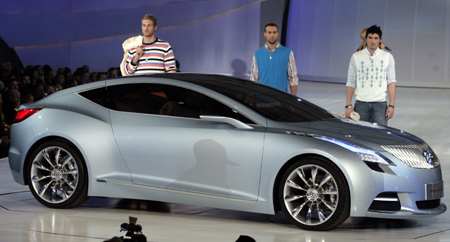Chinese-designed Buick Riviera debuts at Detroit auto show
(Xinhua)
Updated: 2008-01-16 14:18
Updated: 2008-01-16 14:18
DETROIT - The Chinese-designed concept car Buick Riviera has made its debut at the North American International Auto Show that kicked off here Sunday.
 General Motors introduces its Buick Riviera Concept vehicle during the GM Style event in Detroit, Michigan January 12, 2008. [Agencies]
|
Unveiled at China's Auto Shanghai 2007, the front-wheel-drive Riviera concept coupe with gull wings was developed with global design input by the Shanghai-based Pan Asia Technical Automotive Center(PATAC), a design and engineering joint venture between General Motors (GM) and Shanghai Automotive Industry Corporation (SAIC).
"We said last year the Riviera concept made us realize how small the world was - it's not East; it's not West. It's Buick," said Ed Welburn, vice president of GM Global Design, in a statement.
"The reaction to the car around the globe proved that to be very much the case," he added.
Engineered to accommodate a new hybrid system that will go into production this year at Shanghai GM (SGM), GM's flagship joint venture with SAIC, the Riviera features several technological and manufacturing innovations.
They represent the latest achievements of GM and its partners in the promotion and development of alternative propulsion technologies in China, GM said.
"The Riviera concept underscores the diversity, strength and depth of the GM global design and engineering network," Welburn said. "It also reflects PATAC's growing role within the GM Design family and China's significance as the world largest Buick market."
The Riviera marks the return of a renowned Buick nameplate after an eight-year hiatus. Between 1963 and 1999, GM sold more than 1.1 million Rivieras in the United States.
Riviera's enticing curves and "earth and water" interior tones are drawn from diverse inspirations including classic Buicks, ancient Chinese artifacts and modern electronic icons. To PATAC designers, the car, inside and out, communicates universal beauty -- a look that transcends cultural or national boundaries.
PATAC designed the Buick Riviera to accommodate the new hybrid system, which will be introduced in China in 2008 prior to the Beijing Olympics.
|
|
|
||
|
||
|
|
|
|